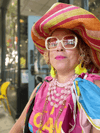Alan Goldfarb was the wine editor at the St. Helena Star, where it is said that assignment must be akin to covering Catholicism in Vatican City. He was also the senior editor for AppellationAmerica.com. His work has appeared in the San Jose Mercury News, Wine Enthusiast, and Decanter. He’s the contributor of the chapter “Chewing on Chile” in the Travelers’ Tales book Adventures in Wine. He was also the technical editor for California Wine for Dummies.
He’s a restaurant wine consultant and advises wineries on public relations projects. (For his “Checking Lists” column, he will not promote his clients.) You can listen to his latest appearance on iWine Radio. Have a question or a comment? You can email Alan. He’d love to hear from you.
Diners Rolling Into Upscale Fog City
On the flip side of the wine list at FOG CITY is a reproduction lithograph of old San Francisco. The print does not depict the city post-Embarcadero Freeway demolition, when Fog City Diner became one of the hottest spots in the city and Cindy Pawlcyn’s original bill of fare emerged as the ubiquitous “small plates” menu. After an extensive remodel, which included dropping “Diner” from the neon marquee, the new Fog City is once again dishing out small plates. But its wine list is as up to date as the north waterfront on which it stands.
In addition to more than a dozen wines on tap—which is as modern as a watering hole can get—with few exceptions, Fog City’s wine list is almost exclusively California-centric. The interlopers are a prosecco and three Champagnes, one of which is the Veuve Clicquot La Grande Dame. At $300, it is the most expensive wine on the list—by far—doubling the Billecart-Salmon brut rosé. (A quibble, though not to be dismissed, is that the two most expensive offerings do not list their vintages on the wine list. The Veuve is from 2004, while the “Billy” is an NV or nonvintage.)
Otherwise, I have no niggling thoughts about the reimagined FC save for the fact that it can get loud as hell and that there is no mention of the wines on Fog City’s website. Which is a pity, because it’s a nice one, put together by Gregory Altzman, late of Poggio in Sausalito.
There are about 60 selections, including the aforementioned keg wines and almost 20 by the glass. The offerings on the wine list range from $29-$300. Perhaps the most interesting white is the Atrea the Choir from Mendocino County. This 70 percent roussanne/30 percent viognier blend is from John Fetzer, who broke away from the family winery to start his own biodynamic project, Saracina. The 2009 wine is priced at $35 and is the oldest white on the list.
My friends and I opted for the 2011 Palmina Honea arneis from Santa Maria ($10 by the glass only). Paired very nicely with deviled eggs topped with fried quinoa and bacon, and spice-seared pole beans, this arneis—an Italian grape grown in central California—had aromas of pear backed with ample acidity with beautiful fruit. It’s one of the best domestic arneis I’ve had.
In the red wine section, try the 2008 Gregory Graham Crimson Hill Lake County syrah and the 2008 D-Cubed Korte Ranch zinfandel. Both wines are a splurge—$67 and $65, respectively—but they’re really good wines with a little bit of age on them.
But for real satisfaction, it’s the 2007 Palmina Santa Barbara County nebbiolo for me. It’s the oldest wine on the list. (I always look for aged wines on restaurant lists, a rarity if it’s affordable. Aged wines have a patina that young wines do not possess.) And at $41, it’s the best bargain at FC. The nebbiolo, with its exotic spice backbone, has an affinity with chef Bruce Hill’s Middle Eastern-spiced food, such as the oyster mushrooms with stewed pimentos with smoked paprika and dill yogurt; and the chicken with spiced Maldon salt.
A couple of other things: the staff seem fairly well trained on the list (not a trifling matter); the stemware is from Spiegelau, a subsidiary of Riedel, and one of the better wineglasses; and most important, the reds were served at a perfect cool temperature, about 60 degrees. Most likely stored in a temp-controlled environment, which is not a common condition in San Francisco, where “room temperature” can sometimes get into the high 70s.
In all, the new Fog City, what with its smart redesign and Middle Eastern-spiced food, is a welcome addition to the bustling Embarcadero. Dropping the “Diner” part of the name removes the casualness the place once boasted and gives it tacit permission, I suppose, to raise prices.
WHAT TO LOOK FOR: 2007 Palmina Nebbiolo, Santa Barbara County ($41)
This is a unique wine because of its aromatics and spices, both of which resemble Middle Eastern smells and tastes. And the fruit: wonderfully fresh, deep-flavored black fruits such as prunes and plums. It’s well balanced and has several years of life ahead. Like its sister arneis on Fog City’s list, nebbiolo is also an Italian varietal—it’s the most important grape of Piemonte in the north—and it’s a good example of the variety, as well as a credit to California winegrowing. As with the arneis, this nebbiolo is grown in Santa Ynez Valley.
Please feel free to email Alan with your comments and your experiences with restaurant wine. He’d love to hear from you.



